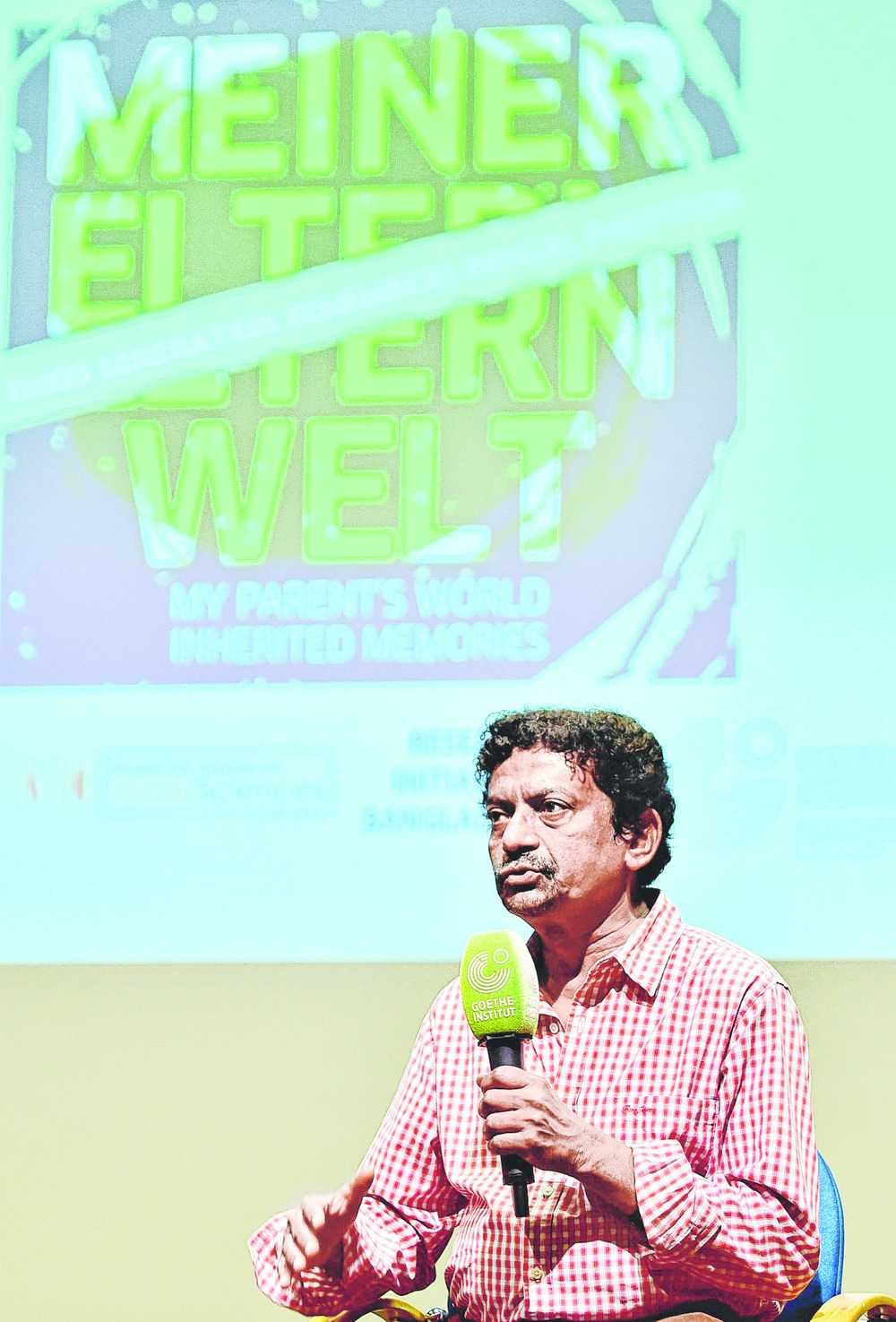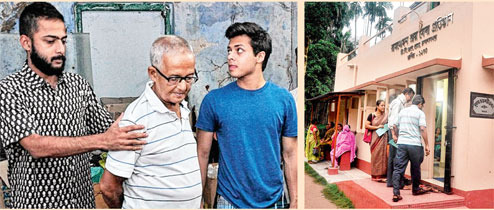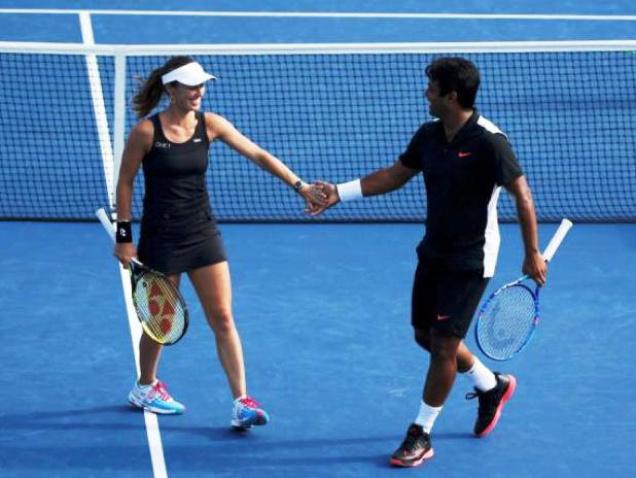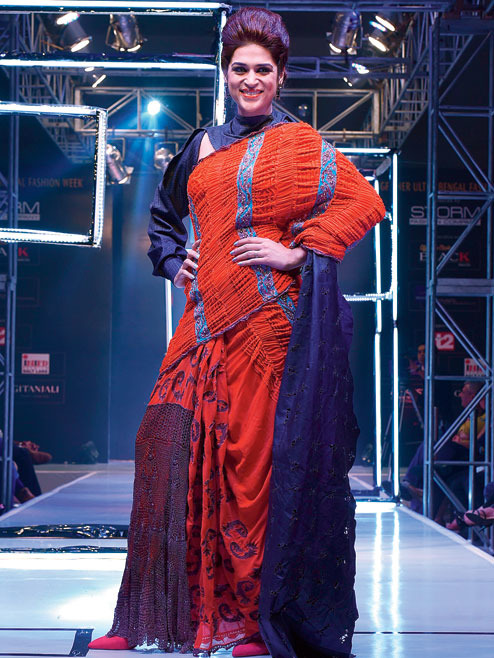Monthly Archives: September 2015
19
18
17
16
Indo-Bangla project on Partition

Director Goutam Ghose often wondered as a 10-year-old why his friends could visit their desher bari during vacations while he could not.
“I remember asking my mother if we have a gramer bari. She would say, ‘achhe, but it is in East Pakistan and we don’t have easy access’,” Ghose said during a recent conference at Max Mueller Bhavan.
The conference kicked off a five-month Indo-Bangladesh project titled My Parent’s World – Inherited Memories, organised by Calcutta and Dhaka’s Goethe Institut.
Ghose narrated how he used to accompany his grandmother to refugee colonies in the Jadavpur and Bijoygarh areas to meet relatives. “I remember my grandmother telling me stories…. When I became a filmmaker, I thought let’s connect. Two races had been divided for a wrong reason. I wanted to go back to my ancestral home and make a film. So I made Padma Nadir Majhi and my father was really happy. He said he was happy that I had chosen the subject as I could go and shoot near the Padma.”
The conference saw speakers like Andrea Zemskov-Zuge from the Berghoff Foundation, Berlin; Manas Ray of the Centre for Studies in Social Sciences, Calcutta; Meghna Guhathakurta, executive director, Research Initiatives, Bangladesh, which works with the marginalised community; and former BBC journalist Nazes Afroz.
Ghose spoke about a village (Chakpanital) where he shot for his upcoming Indo-Bangla film – Shonkhochil. It is a village where there are houses of both sides and people live together.
“I find this two-nation theory absurd… that too on the basis of religion. While making the film, I was studying the Radcliffe Line. It is so strange… how on a huge water body you find a zigzag line separating two nations. Same people, same language, same culture divided by an absurd border. Why did Gandhi not launch a ‘Stop Partition Movement’ like the Quit India Movement?”
As part of the project, eight students from Calcutta travelled to Goethe Institut, Bangladesh, to meet eight students there. Together they will attend conferences and workshops on commemorative culture. “Once both sets of students are trained in interviewing techniques, they will interview third generation families of Partition on both sides of the border. People would be selected to travel to the country of their ancestors,” said Judith Mirschberger, director, Goethe Institut, Bangladesh. “So, someone living in Calcutta would travel to Bangladesh and vice versa to trace his/her family roots with these students.”
The project will end with the launch of a web platform where all interviews and background information will be put up.
From Shahid Minar in Dhaka to a memorial in Bhopal by a Dutch sculptor for victims of the Bhopal gas tragedy, Nazes Afroz, who is also the coordinator of the project, presented a slide show of pictures, while talking on the topic “Visual tool is very important in culture of memory”.
It was after a visit to Dhaka in February 2014 for an exhibition that Friso Maecker, the director of Goethe-Institut, Calcutta, started thinking about the possibility of working together. “I remember we were shooting a documentary film, which was about moving from one place to another…. There’s not been much research on the influence of Partition on third generation people in India as well as in Bangladesh…. Also from the viewpoint of an outsider… it is quite astounding that there is no memorial or place to remember the migration of more than eight million people… Which is why we started the project.”
source: http://www.telegraphindia.com / The Telegraph, Calcutta,India / Front Page> Calcutta> Story / by Malancha Dasgupta / Tuesday – September 15th, 2015
Cousins in arms for cause close to heart

Two do-gooder Calcutta cousins have helped set up a clinic in Chandernagore that offers treatment to those who cannot afford it.
Cousins Rishabh Badoni, 19, a former student of La Martiniere for Boys now studying at Bard College in New York, and Siddharth Sengupta, 23, a Calcutta-based architect, have organised fund-raising exhibitions for three years to develop NGO Ram Mohan Roy Seva Pratisthan’s clinic by the same name – a lifeline for those who cannot avail themselves of costly medical services.
Despite the presence of government medical centres and a sub-divisional hospital in Chandernagore, the common belief is that no other place can provide the same service with care as the doctors and social workers at this clinic can.
Take for instance, Kakoli Singha from Burdwan’s Memari, a widow with two children. She travels for more than an hour by train every morning carrying fresh paneer, which she sells in Chandernagore.
Three years ago she had a skin allergy and got herself treated at Ram Mohan Roy Seva Pratisthan for a nominal fee. Since then, Kakoli has been visiting this clinic for her or her children’s medical needs.
“I used to live with my husband in Chandernagore. After his death, I moved to Memari to live with my in-laws,” Singha said. “But I prefer this clinic as I can consult a doctor and get medicines for a nominal charge. This NGO has been providing good service for so many years… I have faith in them.”
Like Singha, many underprivileged patients from various parts of Hooghly, Burdwan and Bankura get themselves treated at the clinic for a fee of Rs 10.
Every week, from Tuesday to Thursday, the 1,200sq ft clinic is chock-a-block with patients. Three doctors are available for consultation from 4pm. Fifty patients, on average, turn up every day.
“Apart from general physicians, we have a gynaecologist, cardiologist, paediatrician, dermatologist, orthopaedist, psychiatrist and psychologist visiting the clinic throughout the three days,” said Ranjit Kumar Ghosh, the treasurer of Ram Mohan Roy Seva Pratisthan. “We can refer serious cases to doctors who run private chambers in Chandernagore. They see patients for free.”
Medicines are collected from various sources. “We collect free samples from medical representatives as well as from doctors,” said skin specialist Dr Sunil Chandra Dutt, who’s been associated with the clinic for seven years.
Homemaker Surupa Chakraborty visits the clinic in the evenings to take stock of and distribute medicines.

“What we need are nutritional supplements for babies and mothers. I see a several patients with anaemia and gynaecological problems and children suffering from malnutrition,” said gynaecologist Dr Roma Sengupta, who visits the clinic once a week.
A member of the NGO sponsors tests for those who cannot afford it. “We avoid expensive tests, but if there are serious cases where specialist doctors would want more investigation, we request for a discount from diagnostic centres,” said Dutt. “We have several volunteers at the clinic. An executive body runs the NGO… but now we are thinking of setting up a trustee board so that, after us, no one tries to sell or rent the property for other purposes.”
The NGO has been working for the welfare of the underprivileged for the past 42 years.
“The clinic was started by Renuka Betaille, nee Mukherjee, in 1973 in the old post office building. Later, it shifted to the building of the primary school, of which I was the headmaster,” said Ghosh. It was not until 2014 that the clinic got its own building at Goabagan in Chandernagore’s Lalbagan. “Most of what you see here is donated. We collected funds from local people. A resident donated the land.”
Dutt found support in his grandsons, Rishabh and Siddharth, and their friends. A corpus of Rs 1.5 lakh was collected towards constructing the building through an art and photography exhibition and donations from close friends.
The dedication of those working at the clinic motivated Rishabh and Siddharth to do something more for the NGO.
“We have started a new design collective called 145 East, where we design products with traditional Indian handicrafts,” said Rishabh, a student of engineering and literature at New York’s Bard College. “Our first exhibition at Weavers Studio had a theme of gamchha. We designed skirts, tops, tablemats and a whole lot of things using the gamchha.”
Metro had reported in July 2013 how Rishabh, along with Siddharth and friends, had turned his Jodhpur Park home into an art gallery with photographs, paintings and artefacts collected from friends and acquaintances to raise money for the Chandernagore NGO.
The French Consulate and Alliance Francaise, Calcutta, had extended their support to the exhibition-cum-sale that fetched Rs 56,000.
In December 2011, Rishabh with his friend had rushed to AMRI Hospitals in Dhakuria to help in the rescue operation following the fire in Annexe I that took 90 lives.
“Social work runs in our blood and Rishabh and Siddharth have got it from there,” said Dutt.
Rishabh said it was important to support people who were devoted to social work.
Siddharth, who studied architecture at Sardar Vallabhbhai Patel Institute of Technology in Gujarat’s Vasad, is helping with design and production at 145 East. “The last exhibition helped create an awareness about the NGO and we managed to collect Rs 12,000 through it,” said the architect who has just completed a year’s teaching in Gujarat.
source: http://www.telegraphindia.com / The Telegraph, Calcutta,India / Front Page> Calcutta> Story / by Dalia Mukherjee / Monday – September 14th, 2015
Fashion week finale
The second edition of the three-day Bengal Fashion Week, partnered by t2, was brought to a close by city boy Abhishek Dutta.
The showstopper? Shraddha Das (in picture), who has earned her spurs in Telugu, Malayalam and Kannada films, dabbled in Tollywood and is now poised to make it big in Bollywood.
Abhishek presented Anno Domini, a neo-chic fall/winter 2015 line marked by graphic prints, ombre shading, structured silhouettes and layering.
Picture by Rashbehari Das
source: http://www.telegraphindia.com / The Telegraph, Calcutta,India / Front Page> Calcutta> Story / Monday – September 14th, 2015
British-era vault still operating in Kolkata
Kolkata :
Inside the underground chambers of a non-descript office building on BBD Bag’s Netaji Subhas Road, lies a piece of Kolkata’s banking history. Here, in the basement of the four-storeyed structure, constructed by a Gujarati entrepreneur in 1940, Kolkata had one of its first private vaults — The Calcutta Safe Deposit Vault.
In the absence of locker facilities in banks then, it was a huge success with British citizens and business families. Seventy-five years later, the vault — probably the only privately owned one in Kolkata now — still survives.
Spread across 5,000 sqft, the vault has an astounding 8,600 lockers and three strongrooms. Dozens of safes, chests and almirahs, some of which are nearly a century-old, take up space in the strongrooms. Several lockers are still in the name of foreigners who rented them three generations ago. Around 2,000 of these lockers are now ‘dead’ and their holders are untraceable.
But the rest are active, says Sriram Ojha, a member of the board of management that runs the vault.
“We still have clients in USA, UK, Singapore and Canada, apart from all corners of the country. While many have stopped getting in touch with us, the rest are active users of the vault. They have been using it over generations and are keen to carry on. We are delighted to serve them because they are helping to keep this vault alive. It is part of our city’s great history,” Ojha said.
It was his father Amritlal Ojha, a successful industrialist from Kutch in Gujarat who started the vault in a building constructed by him. People like industrialists Badridas Goenka and Nalini Ranjan Sarkar attended the inauguration in January, 1940. It charged clients just Rs 8 every three months for a locker.
Four years later, on October 18, 1944, Amritlal passed away.
“My father had travelled to England to secure permission for the vault and building, which had been denied initially. He was on the board of more than a dozen companies and also president of the Indian Chamber of Commerce and FICCI at New Delhi, apart from numerous other business organizations. He enjoyed a tremendous goodwill in the elite circles of Kolkata, which made it easy for Calcutta Safe Deposit Vault to continue even after his death. Our clients never left us,” Ojha said.
Among those who stored valuables at the vault were the Dalai Lama and the Maharaja of Burdwan. Members of the royal family of Sikkim and the Tata and Birla families still hold some, apart from numerous other rich, aristocratic families in the city. Many of them still visit the vault regularly.
Fresh applications for lockers are still received, though there is hardly any available now. Recently, a client opened a locker that had not been operated for nearly 30 years — a Bengali woman from Texas claimed her husband’s trunk from a strongroom at the vault.
Reminders are sent to old clients to come and check their belongings. “Many respond enthusiastically while others are returned to us for the recipients are either dead or have shifted residence,” Ojha explained.
It is more to carry on his father’s legacy, than anything else, that the vault has been kept running with a workforce of only 20, said the 71-year-old Ojha. “None of his other businesses survive so I am keen that this one exists at least till I am alive. It is a hand-to-mouth existence for the vault since we have hundreds of defaulters. Charges have been revised but the earnings are still not enough to result in a decent profit. But we can still survive,” Ojha said.
There is a set of Reserve Bank of India guidelines for nationalized Bank lockers. But Ojha is not aware of them and he has not been questioned either.
“When my father started it, there was no RBI. But a demand for lockers must have existed as this vault was a runaway success. Our vault is not the only one in the country, there are several others in other cities. But ours was a huge hit,” he argues.
The vault now charges between Rs 800 and Rs 3,000 annually for a loc-ker, depending on its size. The char-ges for renting an almirah, a safe or a trunk are Rs 12,000, Rs 15,000 and Rs 5,000 respectively.
What worries Ojha now is the future. “Rent from the building sustains the company but the major tenant has been defaulting. Unless we can generate more revenue, the vault will pass into history. It sustains nearly a hundred people, which makes it important for me to ensure that it goes on,” Ojha explains.
source: http://www.timesofindia.indiatimes.com / The Times of India / News Home> City> Kolkata / by Prithvijit Mitra, TNN / September 13th, 2015
Paes-Hingis win US Open mixed doubles title

Paes now has nine Grand Slam mixed doubles titles, surpassing compatriot and former partner Mahesh Bhupathi’s record of eight.
Leander Paes created history by winning the U.S. Open mixed doubles title with Swiss partner Martina Hingis and surpassed compatriot and former partner Mahesh Bhupathi’s record.
The 42-year-old Paes now has won nine Grand Slam mixed doubles titles, against Bhupathi’s eight.
The fourth seeded India-Swiss pair, edged past unseeded Americans Bethanie Mattek-Sands and Sam Querrey 6-4 3-6 10-7 in a tricky final to win their third Major title together this season.
Paes is now only behind legendary Martina Navratilova, who won 10 mixed doubles trophies. Of those 10, two came with Paes, when they won Australian Open and Wimbledon in 2003.
With this win, Paes and Hingis, who also won Australian Open and Wimbledon titles early this season, have become the first mixed doubles team since 1969 to win three Grand Slam mixed doubles titles in the same year.
It was Paes’ 17th Grand Slam title overall and Hingis’ 19th. Hingis has won four Grand Slam titles and all of them have come with Indians. She won her first mixed doubles trophy with Bhupathi when they won 2006 Australian Open.
Hingis is also in the contention in the Women’s Doubles with Sania Mirza with whom she won the Wimbledon this year. They are up against Yaroslava Shvedova of Kazakhstan and Casey Dellacqua of Australia.
Paes and Hingis broke Mattek-Sands at love to take a 2-1 lead in the opening set as the Swiss miss hit a forehand passing shot to secure the break. That bit of momentum was all they needed, as Paes easily closed the set out at 5-4 when Hingis hit a volley winner.
A lone break of serve also decided the second set, as Mattek-Sands hit two straight winners to break Hingis’ serve as the Americans led 3-1. Hingis saved three set points on her serve at 2-5, but Querrey easily held in the next game to send the contest into a deciding super tiebreak.
The unseeded Americans were cruising as they created a 4-1 cushion when they won both points on Hingis’ serve to grab the first mini-break. But Hingis and Paes took the mini-break back on Mattek-Sands’ serve at the next opportunity.
The crucial point of the match came at 7-7, when Paes blocked Querrey’s serve for a clean passing-shot winner. He then won both points on his serve to close out the match, hitting an overhead winner on their first match point and then lifting Hingis in celebration.
source: http://www.thehindu.com / The Hindu / Home> Sport> Tennis / PTI / New York – September 12th, 2015
